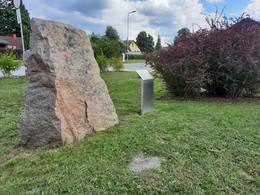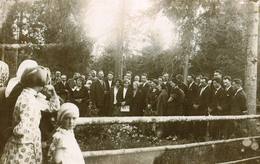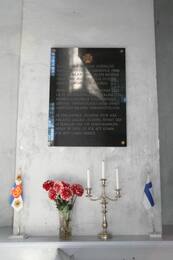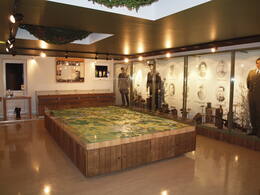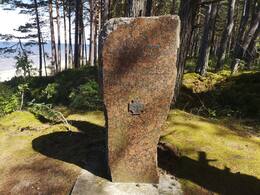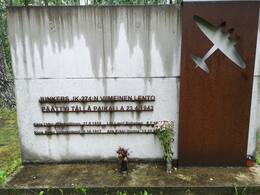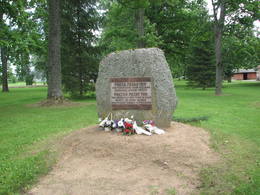Finnish Volunteer Regiment "Boys of the North" ("Pohjan Pojat")
I Wars of Independence
The Northern Boys (Finnish: Pohjan Pojat, Estonian: Põhja Pojad) was a Finnish volunteer regiment during the Latvian and Estonian wars of independence from January to April 1919. The commander-in-chief was the Finnish general Martin Wetzer (1868-1954), who was also the commander of the Estonian Southern Front, while the regiment's commander was the Estonian-born Colonel Hans Kalm (1889-1981). A large part of the soldiers were Finnish jaegers who had previously participated in the battles of World War I in Semigallia. In total, about 3,000–4,000 Finnish volunteer soldiers participated in the hostilities from January to March.
The regiment performed great services in the Battle of Paju (Estonian: Paju lahing) and in the liberation of Valka from the Bolsheviks on February 1, 1919. The "Northern Boys" also distinguished themselves in the battles for the liberation of Alūksne and Beja from the Red Army, where many Finnish soldiers fell.
After the Latvian War of Independence, fourteen soldiers of the regiment, including General M. Vecers and Colonel H. Kalms, were awarded the Lāčplēsis War Order.
Eight (also seven? or nine?) Finnish soldiers who fell in the Battle of Beja on February 22, 1919 are buried in the Beja cemetery. On February 2, 1989, a white wooden cross and a wooden fence were placed in the cemetery, but on May 7, 2000, a memorial stone was unveiled in the Beja cemetery with the inscription "Here rest the soldiers of the Northern Boys of the Finnish Volunteer Regiment who fell in the Battle of Beja in 1919."
On October 17, 1999, a memorial plaque dedicated to Finnish soldiers was unveiled at the Jaunalūksne Parish Local History Center.
In February 2019, marking the 100th anniversary of the Battle of Alūksne, a special boulder from the Salpa Line (Finnish: Salpalinja), which guarded Finland's eastern border with Russia, was installed at the Alūksne railway station.
More information sources
Juris Ciganovs. Finnish “Northern Boys” Fights in Latvia. SARGS.LV, 10.01.2015.: https://www.sargs.lv/lv/starpkaru-periods/2015-01-10/somu-ziemelu-zenu-cinas-latvija#lastcomment
Finnish Soldiers' Cemetery in Beja: https://timenote.info/lv/Somu-karaviru-Bralu-kapi-Beja
Cavaliers of the Order of the Lāčplēsis War: Biographical Dictionary. Riga: Jāņa Sēta, 1995.
Related timeline
Related objects
Memorial stone to the Finnish volunteer regiment "Boys of the North"
Located in Alūksne, at Jāņkalna Street 52, near the Alūksne narrow-gauge railway station.
On February 23, 2019, to mark the centenary of the Latvian War of Independence, at the initiative of the Independence Struggle Traditions Association (Finland), a special memorial site was created to honor the Finnish volunteers who fell for Latvia's independence, where a special boulder and an information plaque testify to the historical events. The memorial stone traveled to Alūksne from Finland - the Salpa Line, which was built in 1940-1944 to protect Finland's Eastern border. The 1,200 km long Salpa Line is one of the most notable defense lines of independent Finland, as well as one of the strongest and best-preserved defense structures of this type in Europe after World War II.
The stone brought to Alūksne symbolizes the struggle of two peoples - the Finns and the Latvians - for their independence. The Finnish volunteer regiment "Boys of the North" went to help the Latvians protect the freedom of the new Latvian state. On February 21, 1919, the "Boys of the North" participated in fierce battles in the vicinity of Alūksne (Marienburg). After a five-hour battle near the Alūksne railway station, the Finns took Alūksne. In this battle, 23 Finnish volunteers lost their lives and many were wounded.
Memorial plaque to the Finnish Jaegers in the Holy Trinity Cathedral in Liepāja
A memorial plaque dedicated to the Finnish Jaegers is located in Liepāja Holy Trinity Cathedral, Lielā iela 9.
The Finnish Jägers were a unit of the German Empire, formed by volunteers from Finland, which, under the name of the 27th Royal Prussian Jäger Battalion, took part in the First World War battles on the Eastern Front of Latvia in 1916-1917.
During World War I, the Grand Duchy of Finland was part of the Russian Empire and many Finns wanted a German victory in the war in order to promote the establishment of an independent state. On 20 November 1914, the Finnish Independence Movement was founded in Helsinki, which also planned to form the armed forces of an independent state. When the German government confirmed its readiness to train the Finns in January 1915, the recruitment of volunteers began and by the spring of 1916 almost 2,000 soldiers were stationed in Germany and were named the 27th Royal Prussian Jäger Battalion.
From June 1916 the battalion was on the Riga front, when it was moved to Liepaja until March 1917. After the February Revolution, the Russian Empire began to collapse and on 6 December 1917 the Finnish Parliament declared independence.
On 13 February 1918, the Battalion swore allegiance to Finland in the Holy Trinity Church in Liepāja. On 15 February 1918, the battalion left the port of Liepaja by ship to return home to the port of Vasa and take part in the Finnish Civil War against the Reds, who had staged a coup d'état on 27 January 1918. The well-trained and combat-experienced Jägers formed the core of the Finnish national army and a large number became commanders during the Second World War.
The battalion's flag, consecrated in Holy Trinity Church, became the first flag of independent Finland.
Museum-room of the Finnish Boys
This museum room is situated in Saadjärve Nature Centre in the small borough of Äksi.
It was opened in 2002 on behalf and with the support of the Finnish Boys Association, Tartu Municipal Government and the Finnish state.
It provides an overview of the battles in Finland and Estonia in which the Finnish Boys participated during World War II. Here you will see a scale model depicting the battles fought in Jõgeva and Tartu counties and the uniforms, equipment, armaments, military decorations, personal belongings and photos of the Finnish Boys. The bunker is also open to visitors.
Free admission.
Monument in the memory of Finnish jaegers-sappers
Located in Engure municipality, on the side of the A10 highway near the Smārde tavern.
The memorial is located in the field opposite the Smårde pub, where the Battle of Smårde took place in 1916 during World War I. A Finnish Jaeger engineer company (~200 men) participated in the fighting as part of the German army. "Smårde Day" has become the official holiday of the military engineers of the Finnish army, which is still celebrated today.
The Finnish Jaegers were a unit of the German Army formed during World War I. They consisted mainly of nationally minded Finnish volunteers from the Russian Empire and Finland. The Battle of Smårde was one of the most significant offensive battles of the Finnish Jaegers, where new tactics were used at the time.
A month after this event, the Russian army attacked the German army near Smārde. Latvian combat units conducted reconnaissance of the Smārde area, built a supply road “Latvian Road” across the swamp, and participated in the fighting. About 300 Latvian fighters fell in the battles. Like the Finnish jaegers in the German army, the Latvian riflemen in the Russian army were the founders of their own national states and armies.
Memorial site for Finnish pilots
Located on the side of the Lilaste-Saulkrasti highway, next to the "Viada" gas station.
The memorial was established in 2013 at the site of a Finnish Air Force plane crash in 1943. Four Finnish army soldiers died in the crash while flying from Germany to Finland. The installation, design and construction of the monument were entirely the initiative of Finnish representatives. It is a tradition of Finnish war pilots to erect memorials at the crash sites of aircraft.
In 1943, Finland purchased 24 modern Junker bombers from Germany. They were intended to supplement the Finnish Army Air Force with modern aircraft. The factory delivered the aircraft in 1943 and, after training the pilots, they were delivered to Finland. The flight of one aircraft ended tragically. Due to technical defects, the pilots were forced to look for a place to make an emergency landing. The aircraft lost altitude, hit trees, crashed into a forest and caught fire. The Finnish pilots were buried in the German army cemetery in Riga during the German occupation of Latvia. They were later reburied in their homeland.
Interestingly, one of the most modern aircraft manufactured in Latvia at the time also crashed in Finland in 1938. It was piloted by Latvian and Finnish army pilots - K. Lešinskis and F. Kuopameki.
Memorial stone to the Finnish volunteer regiment "Boys of the North"
Located in Alūksne, at Jāņkalna Street 52, near the Alūksne narrow-gauge railway station.
On February 23, 2019, to mark the centenary of the Latvian War of Independence, at the initiative of the Independence Struggle Traditions Association (Finland), a special memorial site was created to honor the Finnish volunteers who fell for Latvia's independence, where a special boulder and an information plaque testify to the historical events. The memorial stone traveled to Alūksne from Finland - the Salpa Line, which was built in 1940-1944 to protect Finland's Eastern border. The 1,200 km long Salpa Line is one of the most notable defense lines of independent Finland, as well as one of the strongest and best-preserved defense structures of this type in Europe after World War II.
The stone brought to Alūksne symbolizes the struggle of two peoples - the Finns and the Latvians - for their independence. The Finnish volunteer regiment "Boys of the North" went to help the Latvians protect the freedom of the new Latvian state. On February 21, 1919, the "Boys of the North" participated in fierce battles in the vicinity of Alūksne (Marienburg). After a five-hour battle near the Alūksne railway station, the Finns took Alūksne. In this battle, 23 Finnish volunteers lost their lives and many were wounded.
Monument to the Sons of the North
This monument is dedicated to the Finnish soldiers and officers of the Sons of the North Regiment who fought in the Battle of Paju. Adorned with a brown granite tablet reading "A noble endeavour will forever shine throughout the ebb and flow of time" in Estonian and Finnish, the monument is situated in Paju Manor park near the larger monument to the Battle of Paju. The Finnish government helped to organise the deployment of around 2300 Finnish volunteers in the country. For this, they were required to leave their service in the Finnish Defence Forces. Their arrival in January 1919 was a major turning point in the War of Independence.
Memorial tablet to the Sons of the North
A black granite memorial tablet bearing almost 200 names was placed on the wall of St John’s Church in Valga in 1934 in remembrance of the Finnish volunteers who fell in the Battle of Paju in the War of Independence. It was unveiled in 1934 by then Head of State Konstantin Päts. The polar bear emblem of the Sons of the North Regiment is depicted on the shield above the stone. The tablet was destroyed using pickaxes in 1940. The memorial tablet was unveiled anew on the 80th anniversary of the Battle of Paju in 1999. The first tablet was made in Finland; the second in Tartu.
Memorial stone to the Finnish volunteer regiment "Boys of the North"
Located in Alūksne, at Jāņkalna Street 52, near the Alūksne narrow-gauge railway station.
On February 23, 2019, to mark the centenary of the Latvian War of Independence, at the initiative of the Independence Struggle Traditions Association (Finland), a special memorial site was created to honor the Finnish volunteers who fell for Latvia's independence, where a special boulder and an information plaque testify to the historical events. The memorial stone traveled to Alūksne from Finland - the Salpa Line, which was built in 1940-1944 to protect Finland's Eastern border. The 1,200 km long Salpa Line is one of the most notable defense lines of independent Finland, as well as one of the strongest and best-preserved defense structures of this type in Europe after World War II.
The stone brought to Alūksne symbolizes the struggle of two peoples - the Finns and the Latvians - for their independence. The Finnish volunteer regiment "Boys of the North" went to help the Latvians protect the freedom of the new Latvian state. On February 21, 1919, the "Boys of the North" participated in fierce battles in the vicinity of Alūksne (Marienburg). After a five-hour battle near the Alūksne railway station, the Finns took Alūksne. In this battle, 23 Finnish volunteers lost their lives and many were wounded.
Apriki Museum Collections and Red Partisan Activity Areas
The Apriķi manor house houses the Apriķu Museum, whose exhibits tell about the ancient history of the region. The museum exhibits an exposition about the Finnish military figure Karl Gustav Mannerheim - 175 museum items, the interactive stand "KGMannerheim and Apriķi" (in three languages - Latvian, English and Finnish) with 6 sections - about the Apriķi manor, about KGMannerheim as a commander in the Winter War, as the freedom of Finland the leader of the battles and about his connection with the Aprikais.
The museum also displays World War II items with symbols of the German and Red Army, as well as a map - the areas of activity of the Red Partisans) and descriptions of the Red Partisans.
The Baroque ensemble of the Aprikku manor (Apprikken) building was formed by the Alokste River in the 18th century. at first. 20th century in the beginning, the owner of the manor is Carl Gustav Mannerheim, who later became the president of Finland, and is known as the author of the legendary Mannerheim line - the fortification system during the Winter War.
Related stories
Battle of the Finnish Volunteer Regiment "Northern Boys" in Beja
On February 23, 1919, a reconnaissance unit of the Finnish volunteer regiment "Boys of the North", hoping to obtain additional weapons and ammunition, arrived at the Beja School ravine, where a clash with the Bolsheviks took place (Battle of Babecka). 10 soldiers of the Finnish regiment fell in this battle.
About the Latvian War of Independence and the events of 1919 in Alūksne
On March 27, 1919, the 1st Valmiera Infantry Regiment, together with the Estonian Guards (kaitselit) battalions of Tallinn (then Rēvele) and Tērbatas, as well as three armored trains, began the liberation of Latvia from the Bolsheviks from the banks of the Melnupe River.
About the Latvian War of Independence and the events of 1918 in Alūksne
In 1918, when German troops entered Alūksne, the Latvian rifle battalions retreated to Soviet Russia. By the beginning of December 1918, a German regime was established and reorganizations were carried out. After Germany surrendered in the war, the Bolsheviks returned to Alūksne and restored their power. Finnish volunteers also fought as part of the Estonian army in the Latvian War of Independence. On February 21, 1919, fierce battles took place between the Bolsheviks and the Finnish volunteer regiment “Northern Boys” in Alūksne, near the station.
Anšlavs Eglītis's memories of the Latvian War of Independence and the events of 1919 in Alūksne
On March 27, 1919, the 1st Valmiera Infantry Regiment, together with the Estonian Guards (kaitselit) battalions of Tallinn (then Rēvele) and Tērbatas, as well as three armored trains, began the liberation of Latvia from the Bolsheviks from the banks of the Melnupe River.
Consecration of the Finnish Jaeger flag at Liepāja Holy Trinity Cathedral
The first flag of the Independent Finland was consecrated in 1918 in Liepaja, at the Holy Trinity Church, where the Finnish Jägers took an oath of allegiance to the legitimate government of Independent Finland before going home.





